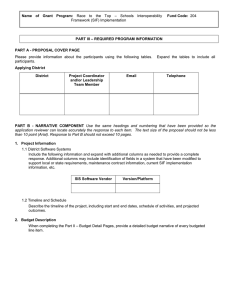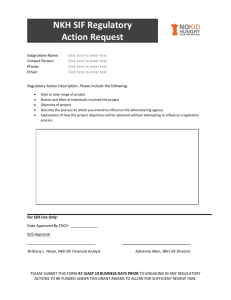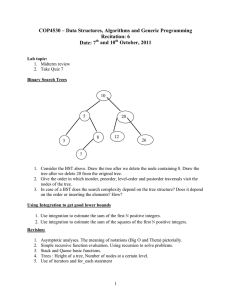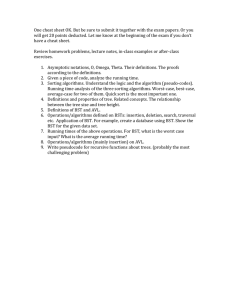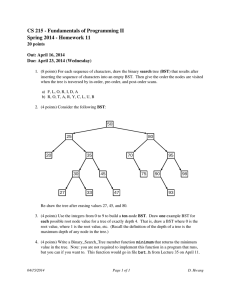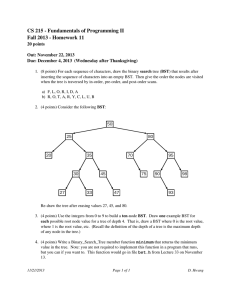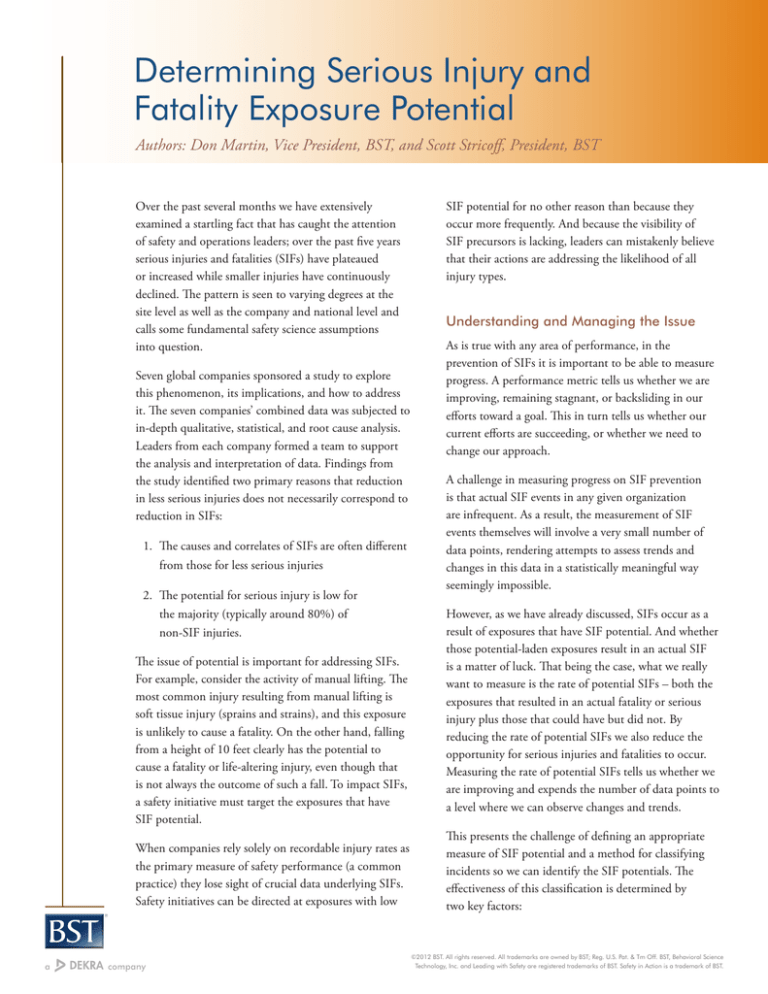
Determining Serious Injury and
Fatality Exposure Potential
Authors: Don Martin, Vice President, BST, and Scott Stricoff, President, BST
Over the past several months we have extensively
examined a startling fact that has caught the attention
of safety and operations leaders; over the past five years
serious injuries and fatalities (SIFs) have plateaued
or increased while smaller injuries have continuously
declined. The pattern is seen to varying degrees at the
site level as well as the company and national level and
calls some fundamental safety science assumptions
into question.
Seven global companies sponsored a study to explore
this phenomenon, its implications, and how to address
it. The seven companies’ combined data was subjected to
in-depth qualitative, statistical, and root cause analysis.
Leaders from each company formed a team to support
the analysis and interpretation of data. Findings from
the study identified two primary reasons that reduction
in less serious injuries does not necessarily correspond to
reduction in SIFs:
1. The causes and correlates of SIFs are often different
from those for less serious injuries
2. The potential for serious injury is low for
the majority (typically around 80%) of
non-SIF injuries.
The issue of potential is important for addressing SIFs.
For example, consider the activity of manual lifting. The
most common injury resulting from manual lifting is
soft tissue injury (sprains and strains), and this exposure
is unlikely to cause a fatality. On the other hand, falling
from a height of 10 feet clearly has the potential to
cause a fatality or life-altering injury, even though that
is not always the outcome of such a fall. To impact SIFs,
a safety initiative must target the exposures that have
SIF potential.
When companies rely solely on recordable injury rates as
the primary measure of safety performance (a common
practice) they lose sight of crucial data underlying SIFs.
Safety initiatives can be directed at exposures with low
SIF potential for no other reason than because they
occur more frequently. And because the visibility of
SIF precursors is lacking, leaders can mistakenly believe
that their actions are addressing the likelihood of all
injury types.
Understanding and Managing the Issue
As is true with any area of performance, in the
prevention of SIFs it is important to be able to measure
progress. A performance metric tells us whether we are
improving, remaining stagnant, or backsliding in our
efforts toward a goal. This in turn tells us whether our
current efforts are succeeding, or whether we need to
change our approach.
A challenge in measuring progress on SIF prevention
is that actual SIF events in any given organization
are infrequent. As a result, the measurement of SIF
events themselves will involve a very small number of
data points, rendering attempts to assess trends and
changes in this data in a statistically meaningful way
seemingly impossible.
However, as we have already discussed, SIFs occur as a
result of exposures that have SIF potential. And whether
those potential-laden exposures result in an actual SIF
is a matter of luck. That being the case, what we really
want to measure is the rate of potential SIFs – both the
exposures that resulted in an actual fatality or serious
injury plus those that could have but did not. By
reducing the rate of potential SIFs we also reduce the
opportunity for serious injuries and fatalities to occur.
Measuring the rate of potential SIFs tells us whether we
are improving and expends the number of data points to
a level where we can observe changes and trends.
This presents the challenge of defining an appropriate
measure of SIF potential and a method for classifying
incidents so we can identify the SIF potentials. The
effectiveness of this classification is determined by
two key factors:
©2012 BST. All rights reserved. All trademarks are owned by BST; Reg. U.S. Pat. & Tm Off. BST, Behavioral Science
Technology, Inc. and Leading with Safety are registered trademarks of BST. Safety in Action is a trademark of BST.
1. Agreement and calibration on the definitions of
“SIF” and “SIF Exposure Potential.”
2. A valid, reliable, and repeatable classification scheme
to evaluate incidents for SIF Exposure Potential.
SIF and SIF Exposure Potential Defined
Each organization must define how broadly it wants to
define the “serious injury” part of “fatalities and serious
injuries.” While fatalities refer to work-related fatal injury
or illness, “serious injury” can be defined more or less
broadly. Two examples follow:
• Example 1: Serious Injury – a life-threatening
work-related injury or illness. Life-threatening
is broadly understood to be a case that required
immediate life-preserving rescue action, and that if
not applied in an immediate fashion, would likely
have resulted in the death of that person. These
cases usually require the intervention of emergency
response personnel to provide life-saving support.
Some common examples would include significant
blood loss, damage to the brain or spinal cord, use of
CPR or AED, chest or abdominal trauma affecting
vital organs and serious burns.
• Example 2: Serious Injury – a life-threatening
or life-altering work-related injury or illness.
Life-threatening is broadly understood to be a
case that required immediate life-preserving rescue
action, and that if not applied in an immediate
fashion, would likely have resulted in the death
of that person. These cases usually require the
intervention of emergency response personnel to
provide life-saving support. Some common examples
would include significant blood loss, damage to the
brain or spinal cord, use of CPR or AED, chest or
abdominal trauma affecting vital organs and serious
burns. Life-altering is generally viewed to be a case
that resulted in a permanent and significant loss of a
major body part or organ function that permanently
changes or disables that person’s normal life
activity. Some examples would include significant
head injuries, spinal cord injuries, paralysis, major
amputations, catastrophic fractured bones, and
serious burns.
How an organization defines SIF is simply a matter of
how broadly or narrowly it wants to focus its special
emphasis. In any organization efforts will continue
to prevent all injuries and illnesses while special
emphasis is placed on SIFs. The appropriate breadth
of that special emphasis will tend to depend on
factors such as the number and types of exposures and
incidents experienced.
With respect to defining SIF-Exposure Potential, a case
can be said to have SIF Exposure Potential when the
incident results in an actual SIF or when the exposure
could have reasonably and realistically resulted in
a fatality or serious injury outcome had any of the
circumstances, factors, or protective measures changed,
and there is a sense that luck or chance had a role to play
in the severity of the actual outcome. In other words,
if the situation was repeated dozens or hundreds of
times, is it reasonable to conclude the outcome would
eventually be a SIF?
The SIF-Exposure Potential Classification
Scheme
At the point the items above are in place, the
organization is ready to design a classification schema to
reliably evaluate incidents for SIF Exposure Potential.
There are two general approaches for these schemas.
One is referred to as the “Judgment-Based Narrative
Review” process, and the other is referred to as the
“Event-Based Decision Tree” process.
Judgment-based Narrative Review
The “Judgment-Based Narrative Review” approach
relies on professional judgment to assess whether the
event could have resulted in a SIF, and uses the accident
report narrative to identify and explore the context
of the exposure situation to identify those cases with
SIF potential. This approach can capture the vast
majority of SIF potential events as long as consistent
screening is accomplished at the local level. Below are
several important steps for effectively implementing a
Judgment-Based Narrative Review process.
Begin by conducting calibration exercises to build high
inter-rater reliability. A tried and tested approach is to
select the group of case assessors (e.g. safety professionals,
supervisors, managers) and review the accident
investigation narratives of approximately 10-20 reported
©2012 BST. All rights reserved. All trademarks are owned by BST; Reg. U.S. Pat. & Tm Off. BST, Behavioral Science
Technology, Inc. and Leading with Safety are registered trademarks of BST. Safety in Action is a trademark of BST.
incident cases, then posing the question “Does this case
have SIF potential – yes or no?” to each member of the
group. As each case is reviewed, the group discusses
the rationale for each “Yes” or “No” rating, clarifying
their respective positions, refining definitions, and
building consensus.
Conduct 3-4 rounds of case reviews until the group
nears 95% or greater agreement. For example, in one
client experience, a team of four reviewers improved their
inter-rater reliability by achieving 100% accurate and
consensus determination as follows:
• Round One = 16 of 21 cases reviewed
• Round Two = 16 of 19 cases reviewed
• Round Three = 31 of 32 cases reviewed
• Round Four = 70 of 70 cases reviewed
Once raters have been trained for effective and reliable
evaluation, the steps they will follow for classifying an
incident are to:
1. Read the complete accident narrative to understand
the context and circumstances surrounding
the accident.
2. Use the agreed-upon definition of “serious
injury.” The key is to understand the concepts of
“life-threatening” or “life-altering” injury or illness.
3. Make a binary Yes/No decision, using the
following guidance:
a. SIF Potential equals “Yes” if one or two of the
circumstances/factors could have obviously, easily,
reasonably changed, and there is clearly a high
probability that the outcome could have become
a Serious Injury (by definition) or Fatality, and
it is more likely than not that luck or chance
prevented it.
b. Another way to approach this is using a
reasonable or practical probability that the event
could have resulted in a serious injury or fatality if
the event was repeated many times.
Examples of how to apply these criteria are shown in the
following table:
INJURY
Fractured
Foot
Laceration
Requiring
Sutures
CASE
DESCRIPTION
SIF
POTENTIAL?
A
Employee suffered a fractured foot when backed over by a Powered Industrial
Truck (PIT) forklift. The PIT operator backed up without looking, and the
backup alarm was not functioning. This easily could have been a serious
(life-threatening or life-altering) injury or fatality if the employee’s full body
had been struck and run over.
YES
B
Employee suffered a fractured foot when they climbed out of a truck cab,
missed the bottom rung of the ladder, and dropped 30 inches to the ground.
Their foot rolled off a small rock, resulting in a fracture.
NO
A
A worker cut his finger on the sharp edge of a pipe flange in the machine
shop. He was grinding the burrs off the flange end, wearing all necessary
PPE. He stopped grinding and removed his glove to feel the edge with
his finger to see if the burrs had been successfully removed. The edge
was sharper than expected, resulting in a cut to the left index finger that
needed two sutures.
NO
B
A 4-foot by 8-foot by 1-inch steel plate was being moved for installation by
two workers using an overhead hoist. The plate shifted unexpectedly and
worker #2 tried to steady it with his hand. The plate shifted again, this time
pinching worker #2’s hand against the steel frame. He sustained a laceration
of his right ring finger, which required sutures to close.
YES
©2012 BST. All rights reserved. All trademarks are owned by BST; Reg. U.S. Pat. & Tm Off. BST, Behavioral Science
Technology, Inc. and Leading with Safety are registered trademarks of BST. Safety in Action is a trademark of BST.
Finger Tip
Amputation
Wrenched
Back
A
Worker was using a 4 pound hammer to drive an anchor bolt, and struck the
tip of their finger, resulting in the amputation of the tip of their thumb.
NO
B
Worker reached into a rotating paper machine calendar to remove a
paper jam. Right index finger was caught in the in-running nip point, the
emergency stop was activated, and the calendar reversed, releasing the finger.
The only injury sustained was an amputation of the finger tip. Clearly, this
event could have resulted in a significantly more serious injury or a fatality.
YES
A
Worker was walking across the floor, slipped on grease, caught himself on a
railing, and wrenched his back (strained back muscle).
NO
B
Worker fell from the top of a rail car when his car was struck by another
rail car that was being moved into position. The worker fell on top of the
tank car, grabbing the guard rail around the dome lid, preventing a fall to
the ground. The only injury resulting was some bruising and a strained back
muscle. Even though this event was classified as “first-aid”, it clearly has high
potential for SIF.
YES
Using this approach, there may occasionally be a “gray
area” where it is difficult to make a Yes/No decision.
For example:
that consistent and accurate classification will be an
ongoing challenge, and that turnover in members of the
assessment team will need to be managed.
Employee fractured foot while working on a ship deck
when he stepped through a large deck/hold opening, and
fell four feet landing upright on top of some grain bags.
The employee suffered strained leg muscles.
Event-based Decision Tree Classification approach
If the individual assessor or assessment team needs
more information to make a Yes/No determination,
they may need to review to case file, interview people
knowledgeable in the incident, or interview the involved
parties. The team or assessor could also decide to ask
one to three other safety professionals to provide their
opinion on the matter, or the team could simply say
“cannot decide” and leave it in the gray area. In BST’s
original SIF research project, this occurred only twice
in 457 cases (and was due to lack of complete narrative
information about the cases).
One downside to the Judgment-Based Narrative
Review approach is that unless every case is reviewed
by the same individual or team it is heavily reliant on
maintaining high inter-rater reliability and preventing
judgment “drift” over time. This approach is best-suited
for organizations with a small team of raters who review
and classify all incidents on a regular basis, and engage
in frequent calibration exercises. Success in using this
approach is more likely in those organizations that
have control over a few sites, or operate as a single site.
Organizations using this approach should recognize
The second, and preferred, approach uses the
characteristics of the incident or near miss to classify a
situation as having SIF potential. The benefits of this
approach are that (1) it is much less dependent on
subjective judgment, so that events can be classified in a
consistent manner by different individuals throughout
an organization (e.g. at the local level where the
incident occurs), and (2) once the system is established
classification it is quick and easy.
In using the event-based approach we begin by
recognizing that there are particular activities which
more naturally lend themselves to producing higher
proportions of precursor events. Examples of these
activities include:
• Operation of mobile equipment and interaction
with pedestrians
• Entering confined spaces
• Performing jobs that require lock-out tag-out
• Operations that entail suspended loads
• Working at height
©2012 BST. All rights reserved. All trademarks are owned by BST; Reg. U.S. Pat. & Tm Off. BST, Behavioral Science
Technology, Inc. and Leading with Safety are registered trademarks of BST. Safety in Action is a trademark of BST.
Beginning with a generic SIF classification decision tree
(see figure 2), an organization can perform a one-time
customization. A small group applies the generic
decision tree to the organization’s incident experience
(injuries, near misses, and process safety events).
After identifying the events that decision tree criteria
indicate are and are not potential SIFs, we are left
with a number of unclassified events. The small group
Does the event involve…?
then does a one-time, judgment-based assessment of
the unclassified events, and from the ones selected
as precursors, modifies the generic decision tree to
one customized to the organization’s exposures. That
customized decision tree can then be used throughout
the organization to drive event-based classification of all
incidents, providing a SIF precursor metric.
Confined
space, LOTO,
SWP, work at height,
fall > 24", hot
work?
YES
NO
YES
Suspended
load?
SIF Exposure
NO
Fire, explosion,
or HazMat
LOPC?
YES
NO
Struck
by/ caught b/w
vehicle or powered
equipment?
YES
YES
Slip/trip/fall at
ground level?
NO
NO
Not SIF
Exposure
YES
Psychological
stress or noise
exposure is sole
stressor?
NO
YES
Physical
over-exertion (sprain/
strain)?
NO
Flag for
further review
©2012 BST. All rights reserved. All trademarks are owned by BST; Reg. U.S. Pat. & Tm Off. BST, Behavioral Science
Technology, Inc. and Leading with Safety are registered trademarks of BST. Safety in Action is a trademark of BST.
With this approach the decisions on events as they
occur are based on the objective criteria of the decision
tree, ensuring consistency. The tree can be applied
locally, so classification/identification of potential SIFs
can occur in real time, facilitating reporting of the
SIF metric. This approach is also quick, as it avoids
case-by-case discussion in the classification process. By
flagging those non-SIF potential events that failed to
meet any of the inclusion or exclusion criteria of the
decision tree, the system can also be self-improving.
The original small group that refined the tree can meet
annually (or at some desired interval) to examine those
cases for characteristics that might result in refinement
of the decision tree.
While some might argue that this approach risks
missing the occasional SIF potential event that has
never been seen before, having a simple classification
process that will be 90% or more accurate and
eliminates inconsistency overcomes those objections
for most people.
Conclusion
Whichever method is used for classifying potential
SIFs, a key first step in reducing fatalities and serious
injuries is establishing and reporting on a metric for
exposure to these incidents. When an organization
supplements its reporting of recordable and lost time
injuries with a rate of SIF exposure events, there is a
basis for assessing progress and detecting increases in
risk. Only when there is visibility of the issue can real
progress be made toward reducing SIF incidents.
417 Bryant Circle, Ojai, California 93023
(805) 646-0166 | fax (805) 646-0328
email: bstusc@bstsolutions.com | www.BSTsolutions.com
©2012 BST. All rights reserved. All trademarks are owned by BST; Reg. U.S. Pat. & Tm Off. BST, Behavioral Science
Technology, Inc. and Leading with Safety are registered trademarks of BST. Safety in Action is a trademark of BST.

